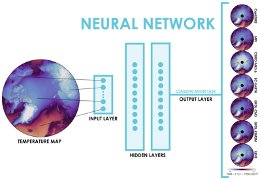Comparison of Climate Model Large Ensembles With Observations in the Arctic Using Simple Neural Networks
Collaborator Prof. Elizabeth Barnes (Colorado State University) and co-author Dr. Zack Labe (CSU, now at GFDL) trained neural networks to identify the climate model given a map of annual Arctic climate. Once trained, explainable AI techniques (XAI) were then used to extract robust differences in the Arctic across climate models. By comparing composites from the attribution method for every GCM classification, we find that the ANN is learning regional temperature patterns in the Arctic that are unique to each GCM relative to the multi-model mean ensemble. Reanalysis fields of the Arctic were also put into the network to determine which climate model the network predicted was most similar.
While there are other existing statistical methods for assessing simulations between different climate models, we introduce a machine learning approach for comparing climate models and observations using a tool called artificial neural networks (ANNs). Overall, we find that the ANN is leveraging regional patterns of temperatures, and not just overall warm and cold biases, in order to make its climate model and observation predictions. Thus, this approach could be useful for understanding climate model differences and biases beyond the regional mean.
Due to many complex processes in the climate system, the Arctic is warming more rapidly relative to other parts of the globe. To understand the impacts of these changes in the Arctic, it is important to evaluate climate model projections. While there are other existing statistical methods for assessing simulations between different climate models, Labe and Barnes (2022) introduce a machine learning approach for comparing climate models and observations using a tool called artificial neural networks (ANNs). Specifically, they train an ANN on maps of annual mean near-surface temperature in the Arctic from a multi-model large ensemble archive in order to classify which GCM produced each temperature map. After training the ANN on data from the large ensembles, they input annual mean maps of Arctic temperature from observational reanalysis and sort the prediction output according to increasing values of the ANN's confidence for each GCM class. To attempt to understand how the ANN is classifying each temperature map with a GCM, they then leverage a feature attribution method from explainable artificial intelligence. By comparing composites from the attribution method for every GCM classification, they find that the ANN is learning regional temperature patterns in the Arctic that are unique to each GCM relative to the multi-model mean ensemble.

